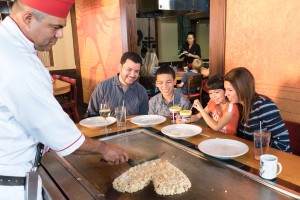WHAT IS THE DIFFERENCE BETWEEN TEPPANYAKI AND HIBACHI GRILLING?
Both teppanyaki and hibachi cooking involve grilling food over an open flame, making it understandable that many people may be confused about these two styles of food preparation. These forms of grilling are used to prepare different types of food and have different origins from each other. Both allow guests to watch the grilling process so that they can witness the great knife and grilling skills of the chefs who prepare their meals.
WHAT IS THE DIFFERENCE BETWEEN TEPPANYAKI AND HIBACHI?
In the U.S., the phrase “hibachi-style” is occasionally used to refer to what is really teppanyaki cooking. Hibachi grills are called shichirin in Japanese and are small, portable barbecue grills that are made from cast iron. These grills have an open-grate design and commonly use charcoal as their heating source. Modern hibachis in U.S. restaurants are electric so that they can be used to cook food indoors. By contrast, teppanyaki grilling involves using an iron griddle with a flat, solid surface to prepare food in restaurants in front of guests. Teppanyaki grills typically use a propane flame as a heat source. Guests are able to sit around the teppanyaki grills so that they can view the skills of the teppan chefs while they grill chicken, pork, beef and seafood dishes. The teppanyaki grill’s surface is also ideal for cooking finely chopped sides such as eggs, vegetables and rice.
ORIGIN AND FEATURES OF THE HIBACHI GRILL
The history of the hibachi grill is thought to date back to the Heian period, which existed between 794 and 1185 AD. The word hibachi means “fire bowl” and refers to the cylindrical shape of the container, which has an open top and is designed to burn wood or charcoal. Hibachi containers are made out of wood or ceramic and are lined with metal. Most hibachi grills are very decorative and some are built into furniture stands for ease of use. When hibachi grills are used in restaurants, they use electricity as a heating source instead of charcoal. They are typically used to cook larger items because of their open-grate design. Hibachi chefs may perform while they cook such as by creating flames that shoot from cones that are built out of onion rings, for example.
ORIGIN AND FEATURES OF THE TEPPANYAKI GRILL
The origins of the teppanyaki grill are unclear. Some people believe that the style of Japanese cuisine dates back to 200 years ago to a time when families would gather together to prepare their dinners over small grills. Most people agree that teppanyaki was first introduced by Japanese chefs as a grilling style in the U.S. Teppan translates as iron plate, and yaki translates as pan-fried or grilled. Teppanyaki grills are found in many Japanese restaurants as long, flat grills around which guests are seated. The chefs grill the food that is ordered in front of the guests, wowing them with their culinary talents and excellent knife skills.
Both teppanyaki and hibachi grilling offer the chance for diners to enjoy delectable Japanese cuisine. When guests go to their favorite Japanese restaurants, they can enjoy their experiences even more by understanding the history of both styles of cooking and the differences between teppanyaki and hibachi grilling methods.
